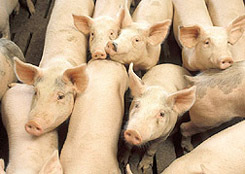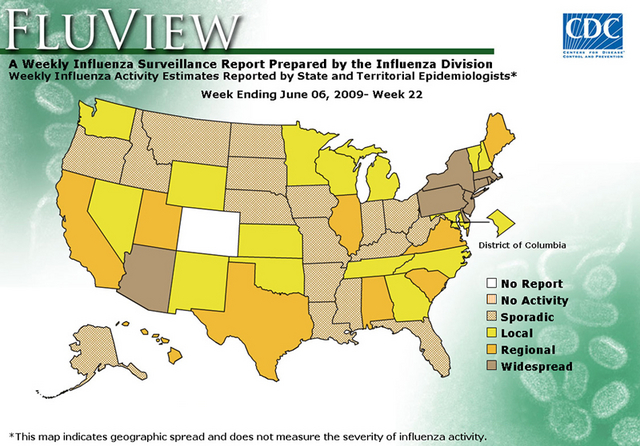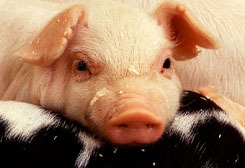
A never before seen strain of swine flu, called A/H1N1, has now killed hundreds of people in Mexico and infected 17,855 people (44 deaths) in the United States.
Novel H1N1 is a new influenza virus causing illness in people. This new virus was first detected in people in the United States in April 2009. Other countries, including Mexico and Canada, have reported people sick with this new virus. This virus is spreading from person-to-person, probably in much the same way that regular seasonal influenza viruses spread.
H1N1 Timeline:
June 15, 2009 -- As of today 76 countries have officially reported 35, 928 cases of influenza A(H1N1) infection, including 163 deaths.
June 12, 2009 - The Swiss pharmaceutical company Novartis says it has produced a first batch of a vaccine to fight the H1N1 swine flu virus, weeks ahead of expectations.
June 11, 2009 - First flu pandemic in 41 years declared! The World Health Organization declared a global H1N1 flu pandemic. A Phase Six pandemic declaration is based on the sustained worldwide spread of H1N1, not the severity of illness caused by the virus
May 29, 2009 - The CDC reports that there have now been 8 deaths from swine flu and 8.975 confirmed cases (15 deaths).
May 22, 2009 - The CDC reports that there have now been 8 deaths from swine flu and 6,552 confirmed cases.
May 21, 2009 - The CDC reports that there have now been 8 deaths from swine flu and 5,710 confirmed cases.
May 14, 2009 - There are now 4,298 confirmed cases of the swine flu in the US. The infections are spread across 47 states and have caused 3 deaths.
May 12, 2009 - The ongoing outbreak of novel influenza A (H1N1) continues to expand in the United States. CDC expects that more cases, more hospitalizations and more deaths from this outbreak will occur over the coming days and weeks.
May 9, 2009 - It's still thought that the A (H1N1) flu spreads in the same way that regular seasonal influenza viruses spread; mainly through the coughs and sneezes of people who are sick with the virus.
May 6, 2009 - The CDC has developed a PCR diagnostic test kit to detect the new H1N1 virus and has now distributed test kits to all states in the U.S. and Puerto Rico. 642 people infected in the U.S..
May 5, 2009 - The CDC expects that more cases, more hospitalizations and more deaths from this outbreak will occur over the coming days and weeks.
May 4, 2009 - 226 infections confirmed in the United States.
May 3, 2009 - The CDC is scheduled to complete deployment of 25 percent of the supplies in the Strategic National Stockpile (SNS) to all states in the continental United States. These supplies and medicines will help states and U.S. territories respond to the outbreak. In addition, the Federal Government and manufacturers have begun the process of developing a vaccine against the novel H1N1 flu virus.
May 2, 2009 - Mothers who are breastfeeding should continue to nurse their babies while being treated for the flu.
May 1, 2009 - There are 141 US cases confirmed in 19 different states. The Mediun age of infected people is 17 years old (range 1-81 years)
April 30, 2009 - The CDC confirms that the swine influenza A (H1N1) virus is susceptible to the prescription antiviral drugs oseltamivir and zanamivir.
April 29, 2009 - Global outbreak of the disease is imminent now according to the World Health Organization. 92 people in the US are infected.
April 28, 2009 - The swine flu outbreak continues to grow in the United States and internationally. Today, CDC confirms that 64 cases have been confirmed in the US.
April 27, 2009 - The CDC confirms 40 cases of swine flu (some news outlets are reporting 44 cases). The WHO Director-General, Dr Margaret Chan, has raised the level of influenza pandemic alert from the current phase 3 to phase 4.
April 26, 2009 - The CDC now confirms 20 cases of swine flu in the US. The Obama administration has declared a "public health emergency"
April 25, 2009 - Breaking story --This evening the CDC's media relations office confirmed to a Neighborhood Link Correspondent that there are now 8 laboratory-confirmed cases of swine influenza A (H1N1) in the United States. The CDC went on to specify that there have been 6 cases in San Diego County and Imperial County, California as well as 2 cases in San Antonio, Texas.
April 25, 2009 - The World Health Organization is convening an expert panel to determine if the pandemic threat level will be raised.

How To Avoid The 2009 Swine Flu
There are everyday actions people can take to stay healthy.
- Cover your nose and mouth with a tissue when you cough or sneeze. Throw the tissue in the trash after you use it.
- Wash your hands often with soap and water, especially after you cough or sneeze. Alcohol-based hands cleaners are also effective.
- Avoid touching your eyes, nose or mouth. Germs spread that way.
Try to avoid close contact with sick people.
- Influenza is thought to spread mainly person-to-person through coughing or sneezing of infected people.
- If you get sick, the CDC recommends that you stay home from work or school and limit contact with others to keep from infecting them.
What is Swine Flu?
Swine Influenza (swine flu) is a respiratory disease of pigs caused by type A influenza virus that regularly causes outbreaks of influenza in pigs. Swine flu viruses cause high levels of illness and low death rates in pigs. Swine influenza viruses may circulate among swine throughout the year, but most outbreaks occur during the late fall and winter months similar to outbreaks in humans. The classical swine flu virus (an influenza type A H1N1 virus) was first isolated from a pig in 1930.
How many swine flu viruses are there?
Like all influenza viruses, swine flu viruses change constantly. Pigs can be infected by avian influenza and human influenza viruses as well as swine influenza viruses. When influenza viruses from different species infect pigs, the viruses can reassort (i.e. swap genes) and new viruses that are a mix of swine, human and/or avian influenza viruses can emerge. Over the years, different variations of swine flu viruses have emerged. At this time, there are four main influenza type A virus subtypes that have been isolated in pigs: H1N1, H1N2, H3N2, and H3N1. However, most of the recently isolated influenza viruses from pigs have been H1N1 viruses.
Swine Flu in Humans

Can humans catch swine flu?
Swine flu viruses do not normally infect humans. However, sporadic human infections with swine flu have occurred. Most commonly, these cases occur in persons with direct exposure to pigs (e.g. children near pigs at a fair or workers in the swine industry). In addition, there have been documented cases of one person spreading swine flu to others. For example, an outbreak of apparent swine flu infection in pigs in Wisconsin in 1988 resulted in multiple human infections, and, although no community outbreak resulted, there was antibody evidence of virus transmission from the patient to health care workers who had close contact with the patient.
How common is swine flu infection in humans?
In the past, CDC received reports of approximately one human swine influenza virus infection every one to two years in the U.S., but from December 2005 through February 2009, 12 cases of human infection with swine influenza have been reported.
What are the symptoms of swine flu in humans?
The symptoms of swine flu in people are expected to be similar to the symptoms of regular human seasonal influenza and include fever, lethargy, lack of appetite and coughing. Some people with swine flu also have reported runny nose, sore throat, nausea, vomiting and diarrhea.
Can people catch swine flu from eating pork?
No. Swine influenza viruses are not transmitted by food. You can not get swine influenza from eating pork or pork products. Eating properly handled and cooked pork and pork products is safe. Cooking pork to an internal temperature of 160°F kills the swine flu virus as it does other bacteria and viruses.
How does swine flu spread?
Influenza viruses can be directly transmitted from pigs to people and from people to pigs. Human infection with flu viruses from pigs are most likely to occur when people are in close proximity to infected pigs, such as in pig barns and livestock exhibits housing pigs at fairs. Human-to-human transmission of swine flu can also occur. This is thought to occur in the same way as seasonal flu occurs in people, which is mainly person-to-person transmission through coughing or sneezing of people infected with the influenza virus. People may become infected by touching something with flu viruses on it and then touching their mouth or nose.
What do we know about human-to-human spread of swine flu?
In September 1988, a previously healthy 32-year-old pregnant woman was hospitalized for pneumonia and died 8 days later. A swine H1N1 flu virus was detected. Four days before getting sick, the patient visited a county fair swine exhibition where there was widespread influenza-like illness among the swine.
In follow-up studies, 76% of swine exhibitors tested had antibody evidence of swine flu infection but no serious illnesses were detected among this group. Additional studies suggest that one to three health care personnel who had contact with the patient developed mild influenza-like illnesses with antibody evidence of swine flu infection.
How can human infections with swine influenza be diagnosed?
To diagnose swine influenza A infection, a respiratory specimen would generally need to be collected within the first 4 to 5 days of illness (when an infected person is most likely to be shedding virus). However, some persons, especially children, may shed virus for 10 days or longer. Identification as a swine flu influenza A virus requires sending the specimen to CDC for laboratory testing.
What medications are available to treat swine flu infections in humans?
There are four different antiviral drugs that are licensed for use in the US for the treatment of influenza: amantadine, rimantadine, oseltamivir and zanamivir. While most swine influenza viruses have been susceptible to all four drugs, the most recent swine influenza viruses isolated from humans are resistant to amantadine and rimantadine. At this time, CDC recommends the use of oseltamivir or zanamivir for the treatment and/or prevention of infection with swine influenza viruses.
What other examples of swine flu outbreaks are there?
Probably the most well known is an outbreak of swine flu among soldiers in Fort Dix, New Jersey in 1976. The virus caused disease with x-ray evidence of pneumonia in at least 4 soldiers and 1 death; all of these patients had previously been healthy. The virus was transmitted to close contacts in a basic training environment, with limited transmission outside the basic training group. The virus is thought to have circulated for a month and disappeared. The source of the virus, the exact time of its introduction into Fort Dix, and factors limiting its spread and duration are unknown. The Fort Dix outbreak may have been caused by introduction of an animal virus into a stressed human population in close contact in crowded facilities during the winter. The swine influenza A virus collected from a Fort Dix soldier was named A/New Jersey/76 (Hsw1N1).
Is the H1N1 swine flu virus the same as human H1N1 viruses?
No. The H1N1 swine flu viruses are antigenically very different from human H1N1 viruses and, therefore, vaccines for human seasonal flu would not provide protection from H1N1 swine flu viruses.
Swine Flu in Pigs

How does swine flu spread among pigs?
Swine flu viruses are thought to be spread mostly through close contact among pigs and possibly from contaminated objects moving between infected and uninfected pigs. Herds with continuous swine flu infections and herds that are vaccinated against swine flu may have sporadic disease, or may show only mild or no symptoms of infection.
What are signs of swine flu in pigs?
Signs of swine flu in pigs can include sudden onset of fever, depression, coughing (barking), discharge from the nose or eyes, sneezing, breathing difficulties, eye redness or inflammation, and going off feed.
How common is swine flu among pigs?
H1N1 and H3N2 swine flu viruses are endemic among pig populations in the United States and something that the industry deals with routinely. Outbreaks among pigs normally occur in colder weather months (late fall and winter) and sometimes with the introduction of new pigs into susceptible herds. Studies have shown that the swine flu H1N1 is common throughout pig populations worldwide, with 25 percent of animals showing antibody evidence of infection. In the U.S. studies have shown that 30 percent of the pig population has antibody evidence of having had H1N1 infection. More specifically, 51 percent of pigs in the north-central U.S. have been shown to have antibody evidence of infection with swine H1N1. Human infections with swine flu H1N1 viruses are rare. There is currently no way to differentiate antibody produced in response to flu vaccination in pigs from antibody made in response to pig infections with swine H1N1 influenza.
While H1N1 swine viruses have been known to circulate among pig populations since at least 1930, H3N2 influenza viruses did not begin circulating among US pigs until 1998. The H3N2 viruses initially were introduced into the pig population from humans. The current swine flu H3N2 viruses are closely related to human H3N2 viruses.
Is there a vaccine for swine flu?
Vaccines are available to be given to pigs to prevent swine influenza. There is no vaccine to protect humans from swine flu. The seasonal influenza vaccine will likely help provide partial protection against swine H3N2, but not swine H1N1 viruses.
 Print
Print Email
Email







